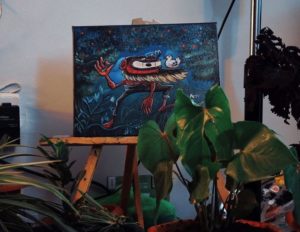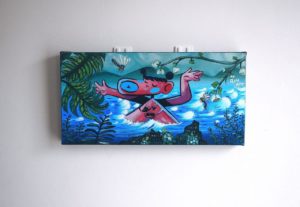Art is a reflection of society, and African art is no exception. Art has been an integral part of African culture for millennia, serving as a means of communication, expression, and identity. From the intricate carvings of ancient Egypt to the vibrant textiles and masks of West Africa, traditional African art is renowned for its beauty, symbolism, and spiritual significance.
However, for many contemporary African artists, navigating the art world can be challenging. In a society where artistic expression is often met with religious and societal pressure to conform, the pursuit of a career in the arts can be a daunting task. Regardless, as is evident from the case of visual artist Reuben Atiti (ReuATT), creating a bubble free from these pressures can lead to artistic emancipation and success! Growing up in Kenya, Reuben was told that he needed to conform to a certain image to be successful. Brought up in a Christian household, he was discouraged from drawing anything deemed “unholy”, which included skulls and fantastical creatures.

Some of Reuben’s paintings
“Growing up as a Christian, I had to conform to “holistic” images and was forbidden from drawing anything considered “unholy”. If I drew a skull, I was labeled an anti-christ, and if I drew a fantastical creature, I was accused of being Illuminati. Ironically, now as an artist, I wish for that title as it signifies importance. However, as a teen, these labels damaged my confidence and drove me to destroy my art. Even my own grandmother warned me that I’d go crazy if I kept drawing”.
As he got older, Reuben realised that there were other paths to success than conforming to these societal expectations.
“I discovered long ago it is important to create a bubble where you can practice your art free from religious and societal pressure to conform if one is serious about a career in the arts.”
Reuben’s experience reflects this reality. The Kenyan art scene is still greatly stuck in its colonial past, catering to old European patrons who want romanticised depictions of Africa. For artists like Reuben, this means that to make a living, they must produce art that conforms to these expectations. Reuben, however, was determined to break free from these constraints.
“I cast away the yoke of religion and cultural persecution and built a bubble where I could express myself freely,” Reuben said. “Nowadays, I earn my living being an artist. Most people in Kenya still don’t know exactly what it is. And in a country where the arts are not appreciated widely, people still look down at artists as broke weirdos. Every day, I’m grateful for the invention of the internet. Most of my clients hail from countries with a stronger appreciation of the arts, mostly in the Western world.”

A Green Place
The internet has provided a platform for African artists to showcase their work to a global audience. Through social media and online galleries, artists like Reuben can connect with clients who appreciate their unique perspectives and styles. This has also created opportunities for artists to collaborate with other creatives worldwide, breaking down cultural barriers and fostering creativity and innovation.

In many African countries, artists face persecution, state censorship, and violence. Artists do more than just express themselves – they may also use their work for social commentary and to support certain causes. Many artists across Africa use their creative expression to fight for human rights, putting them at odds with their governments or other powerful actors. In 2021, Freemuse, an international organisation that advocates for freedom of artistic expression, documented 1251 acts of violations of artistic freedom, of which 74% were committed to silencing artists and their artistic work. 7% of the violations originated from sub-Saharan Africa.
Despite facing numerous challenges, African artists continue to thrive, creating work that challenges societal norms and inspires new generations. As society evolves, so does the art it produces. Through their art, African artists are reshaping the continent’s cultural landscape, celebrating its diversity, and forging new paths for future generations.
Reuben’s unwavering resilience and unrelenting determination are nothing short of inspirational. As a creative writer navigating similar challenges in Kenya, I cannot help but feel inspired by his story. As a storyteller, my journey has been a bumpy ride filled with diverse experiences and challenges. I encountered an unexpected roadblock from established authors who expected my stories to conform to a particular trope of the Kenyan experience that did not align with my perspective. Despite the discouragement, I refused to give up on my passion and continued to write from my heart. Despite the numerous obstacles, my love for writing has continued to fuel my journey, and my unique perspective and voice have allowed me to make a mark as a writer and storyteller.
As the African art scene continues to grow and expand, the future is indeed looking bright for those brave enough to pursue their passions and carve out their paths to greatness. So let Reuben’s journey be a beacon of hope for all aspiring artists – the world is waiting for you to shine!
To learn more about Reuben’s artwork, visit here.
Author: Gentrix Barasa
Gentrix Ayoti Barasa is a communications, research, and advocacy professional currently working for AfricanDefenders/DefendDefenders. With a passion for creative writing and storytelling, she aspires to promote human rights and equality in Africa. Gentrix is committed to using her expertise in communication to raise awareness on issues of social justice and inspire change.
Bibliography
- Korir Michelle (2022) “Do We Still Need Gatekeepers in Publishing.” Available at:
https://mysterypublisherslimited.com/do-we-still-need-gatekeepers-in-publishing/
- Freemuse (2022) “ The State of Artistic Freedom 2022.” Available at:
https://freemuse.org/media/yk2paxxb/saf-report-2022.pdf
- Matsengarwodzi Derick (2021) “What this generation wants: African authors
publishing direct to the web.” Available at:
- Musangi Neo (2017) “Kenya is Another Country.” Available at :
https://contemporaryand.com/magazines/kenya-is-another-country/
- Halliday Craig (2016) “Tracing the Emergence of Contemporary Visual Art Practice in
Nairobi.” Available at: https://africanah.org/tracing-the-emergence-of-contemporary-visual-art-practice-in-nairobi41/
- Rusbridger Alan (2016) “Kenya: The Devious Art of Censorship.” Available at:
https://www.nybooks.com/articles/2016/12/08/kenya-devious-art-of-censorship/
- Khan Sharlene (2007) “Gatekeeping Africa.” Available at:
artlink.com.au/articles/2959/gatekeeping-africa/
All Images
© Instagram: @reu.att
